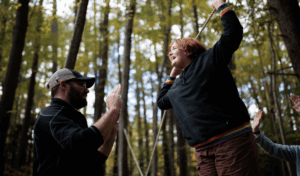Ever feel “out of your body” when severely anxious? Ever experienced the grounding effects of big a hug? What happens to our sense of body awareness when we are anxious? And how can we engage our sensory system to manage acute feelings of fear?
Most people are familiar with the classic five: smell, touch, taste, sight, and sound. However, many people are not aware of the other sensory systems that are essential to our human experience. One of which is proprioception.
Proprioception is your sense of body awareness. Within our skin, muscles, and joints, live tiny little receptors called proprioceptors, who are responsible for perceiving our body position and our movement. These receptors send signals to our brain, telling it where our body is in relation to itself or the external environment. This is the sense that allows you tell how far away something is when you go to grab it or whether your arm is in the right position to catch a ball.
Like all other sensory systems, our proprioceptive system is directly related to autonomic nervous system, and therefore plays a role in sympathetic arousal (“fight, flight, and freeze”) and parasympathetic arousal (“rest and digest”). Research has shown that when our sympathetic system is engaged, our sense of proprioception is impaired. This would explain that “vertigo” and “out of body” experience people often describe during high states of anxiety. However, the inverse relationship is also true, and when proprioceptive system is engaged, it stimulates our parasympathetic nervous system, helping us to move to calmer state of being.
So how do we engage our proprioceptive system? Here a few quick tips:
Do “Heavy Work” – to engage the proprioceptive system, we need to engage the muscles, tendons, and joints of our body. One of the easiest ways to do this is through “heavy work”, such as:
- Lifting weights
- Using resistance bands
- Push/Pull activities
- Yardwork/gardening tasks (shoveling, moving a wheel barrel, lifting heavy objects, etc.)
Apply Deep Pressure – Another way to get input to the muscles, tendons, and joints of your body is to apply pressure to them. So yes, your deep tissue massage can help with your anxiety! Here is a list of few examples:
- Massage
- Weighted items (weighed blankets, vests, etc.)
- Stress balls or thera-puddy (pressure to the hands)
- Chewing gum (pressure to the jaw)
- Hugs
Foster Body Awareness & Coordination – finally, activities that require one to coordinate their body in space also inherently engage the proprioceptive system. These activities may include:
- Yoga
- Tai Chi
- Body scans
- Climbing
- Hiking (especially on uneven terrain!)


